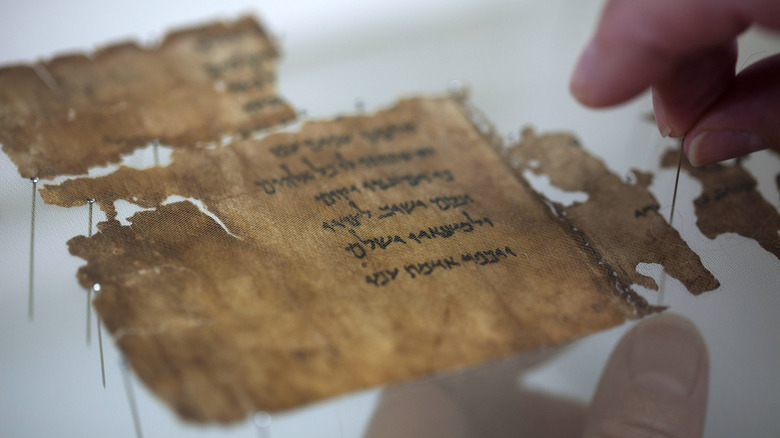How Animal DNA Is Crucial To Solving The Dead Sea Scrolls
The Dead Sea Scrolls rank pretty highly on the holy book literary list, if only because of how closely they resemble the Hebrew Scriptures — what Christians refer to as the Old Testament. None of that "Judas was in on the whole thing" schtick from the Gospel of Judas, discovered in the 1970s. None of that "Solomon was a magic ring-wearing wizard who forced demons to engage in First Temple labor" stuff from the Pseudepigrapha. None of that "God is actually an insane entity called the Demiurge cast out of Plemora, the fullness of Heaven, by Sophia, aeon of the divine" stuff from ancient Gnosticism.
No, the Dead Sea Scrolls, discovered in 1947, stashed in a set of caves at the hermetic Jewish community at Qumran west of the Dead Sea, are basically the oldest version we have of the Hebrew Scriptures. They're written in Hebrew (not Greek, Aramaic, or other ancient languages), contain some of-interest items like "previously unknown hymns, prayers, commentaries, mystical formulas," as Smithsonian Magazine states, and the Temple Scroll – the longest scroll — describes not only how to build the aforementioned First Temple, but why the nearest toilet to it should be 3,000 cubits (one mile) away.
The Dead Sea Scrolls (note the plural) are composed of 25,000 fragments of text scattered across hundreds of manuscripts, some of them in better condition than others. We have the dry cave air to thank for that, as well as the material upon which the authors wrote: animal skin.
DNA testing on manuscripts reveals their origins
In general, we know that the Dead Sea Scrolls were written from around 200 BCE to 66-70 CE, per Smithsonian Magazine, when they were stashed to keep them safe. Beyond that, the process of reconstructing the scrolls' some 25,000 fragments has proved a daunting, decades-long process. But if the Dead Sea Scrolls are composed of animal skins, then we can examine the animals' DNA to learn a bit more about how, when, and where the scrolls were written.
In 2020, National Geographic ran a story describing DNA analyses on 26 of the scrolls' fragments. All but two of them were written on sheepskin. One of the non-sheepskin fragments, a piece of cow hide, belonged to a version of the Book of Jeremiah that researchers had previously wrongfully connected to a different manuscript. This is extremely telling, as Noam Mizrahi, biblical scholar at Tel Aviv University says, because it means that the different versions of Jeremiah originated in different regions.
Researchers were even able to distinguish between not only different species, but different flocks of sheep. They connected sheep RNA to stylistic differences between texts, indicating that shepherds and associated Jewish communities were responsible for particular manuscripts. The Jews at Qumran — a somewhat fringe, monastic group — consolidated various manuscripts, we assume, for whatever reason; perhaps archival. In turn, this helps shed light on the validity of not only the Dead Sea Scrolls as a whole, but each individual text.

